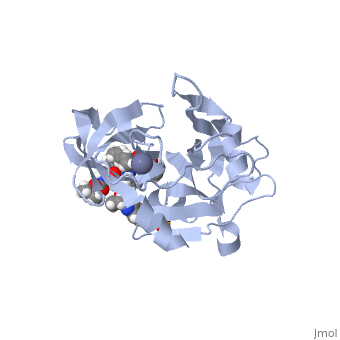Zepatier
From Proteopedia
(Difference between revisions)
(New page: [http://www.example.com link title]<scene name='74/745998/Grazoprevir/3'>Text To Be Displayed</scene><StructureSection load='5EPY' size='340' side='right' caption='Zepatier: A combination ...) |
|||
| Line 20: | Line 20: | ||
== Disease in Humans == | == Disease in Humans == | ||
| - | Hepatitis C, hereafter known as HCV, is a viral infection that causes inflammation of the liver and decreasing liver functioning. First isolated by Michael Houghton in 1989, hepatitis C was discovered to encode a single polyprotein of 3,000 amino acids later cleaved into 10 polypeptides. Polypeptides produced include p7 ion channel proteins, the core protein, glycoproteins envelope 1 (E1) and envelope 2 (E2), and nonstructural proteins NS1, NS2, NS3, NS4A, NS5A, and NS5B. The 5’ untranslated region of HCV is not capped, allowing it to fold into a complex secondary RNA structure hereby creating an internal ribosome entry site that is able to direct ribosomal subunits and cellular factors, and as a result, translation. Development of cell culture based model systems have allowed for the study of the HCV lifecycle <ref>Chevaliez, S.; Pawlotsky, J. M. Virology of hepatitis C virus infection. Best Pract. Res. Clin. Gastroenterol.2012, 26, 381-389.</ref>. | + | Hepatitis C[http://www.cdc.gov/hepatitis/hcv/index.htm], hereafter known as HCV, is a viral infection that causes inflammation of the liver and decreasing liver functioning. First isolated by Michael Houghton in 1989, hepatitis C was discovered to encode a single polyprotein of 3,000 amino acids later cleaved into 10 polypeptides. Polypeptides produced include p7 ion channel proteins, the core protein, glycoproteins envelope 1 (E1) and envelope 2 (E2), and nonstructural proteins NS1, NS2, NS3, NS4A, NS5A, and NS5B. The 5’ untranslated region of HCV is not capped, allowing it to fold into a complex secondary RNA structure hereby creating an internal ribosome entry site that is able to direct ribosomal subunits and cellular factors, and as a result, translation. Development of cell culture based model systems have allowed for the study of the HCV lifecycle <ref>Chevaliez, S.; Pawlotsky, J. M. Virology of hepatitis C virus infection. Best Pract. Res. Clin. Gastroenterol.2012, 26, 381-389.</ref>. |
HCV is transmitted exclusively through blood whereupon the virus travels to the hepatocytes of the liver to undergo rapid replication. This results in the inflammation of the liver, leading to decreased function and/or liver failure. HCV induces an immune response within the infected individual which commonly fails to restrict the development of chronicity. | HCV is transmitted exclusively through blood whereupon the virus travels to the hepatocytes of the liver to undergo rapid replication. This results in the inflammation of the liver, leading to decreased function and/or liver failure. HCV induces an immune response within the infected individual which commonly fails to restrict the development of chronicity. | ||
Revision as of 15:43, 4 December 2016
link title
| |||||||||||
References
- ↑ Soumana DI, Kurt Yilmaz N, Prachanronarong KL, Aydin C, Ali A, Schiffer CA. Structural and Thermodynamic Effects of Macrocyclization in HCV NS3/4A Inhibitor MK-5172. ACS Chem Biol. 2015 Dec 18. PMID:26682473 doi:http://dx.doi.org/10.1021/acschembio.5b00647
- ↑ Coburn CA, Meinke PT, Chang W, Fandozzi CM, Graham DJ, Hu B, Huang Q, Kargman S, Kozlowski J, Liu R, McCauley JA, Nomeir AA, Soll RM, Vacca JP, Wang D, Wu H, Zhong B, Olsen DB, Ludmerer SW. Discovery of MK-8742: an HCV NS5A inhibitor with broad genotype activity. ChemMedChem. 2013 Dec;8(12):1930-40. doi: 10.1002/cmdc.201300343. Epub 2013 Oct, 14. PMID:24127258 doi:http://dx.doi.org/10.1002/cmdc.201300343
- ↑ National Center for Biotechnology Inforamtion. PubChem Compound Database; CID=71661251, https://pubchem.ncbi.nlm.nih.gov/compound/71661251#section=Chemical-and-Physical-Properties
- ↑ doi: https://dx.doi.org/http
- ↑ Fridell RA, Qiu D, Valera L, Wang C, Rose RE, Gao M. Distinct functions of NS5A in hepatitis C virus RNA replication uncovered by studies with the NS5A inhibitor BMS-790052. J Virol. 2011 Jul;85(14):7312-20. doi: 10.1128/JVI.00253-11. Epub 2011 May 18. PMID:21593143 doi:http://dx.doi.org/10.1128/JVI.00253-11
- ↑ National Center for Biotechnology Information. PubChem Compound Database; CID=44603531, https://pubchem.ncbi.nlm.nih.gov/compound/44603531.
- ↑ Chevaliez, S.; Pawlotsky, J. M. Virology of hepatitis C virus infection. Best Pract. Res. Clin. Gastroenterol.2012, 26, 381-389.
- ↑ Petrescu, I. O.; Biciusca, V.; Taisescu, C. I.; Alexandru, D. O.; Taisescu, O.; Comanescu, M. V.; Petrescu, F.; Popescu, I. A.; Trasca, D. M.; ForTofoiu, M. C.; Silosi, C. A.; ForTofoiu, M. Histological factors that predict the liver fibrosis in patients with chronic hepatitis C. Rom. J. Morphol. Embryol. 2016, 57, 759-765.
[1] [2] [3] [4] [5] [6] [7] [8]

